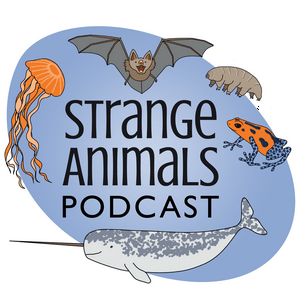Episode 444: Diskagma and Horodyskia
It's Invertebrate August! These creatures are the most invertebrate-y of all!
Further reading:
Dubious Diskagma
Horodyskia is among the oldest multicellular macroorganisms, finds study
A painting of diskagma, taken from the top link above:
Little brown jug flowers (not related to diskagma in any way!):
Show transcript:
Welcome to Strange Animals Podcast. I’m your host, Kate Shaw.
This episode started out as the March 2025 Patreon episode, but there was more I wanted to add to it that I didn’t have time to cover in that one. Here’s the expanded version to kick off Invertebrate August, which also happens to be episode 444 and releasing on August 4th! It’s about two mystery fossils.
The first is named Diskagma, which means disc-shaped fragment, and it was only described in 2013. That’s partly because it’s so small, barely two millimeters long at most, and partly because of where it’s found. That would be fossilized in extremely old rocks.
When I saw the illustration accompanying the blog post where I learned about Diskagma, I thought it was a cluster of cup-like flowers, sort of like the flowers of the plant called little brown jug. I was ready to send the link to Meredith Hemphill of the Herbarium of the Bizarre podcast, which by the way you should be listening to. But then I saw how old Diskagma is.
It’s been dated to 2.2 billion years old. That’s older than any plant, probably by as much as a billion years.
Even more astounding, it lived on land.
As a reminder, the Cambrian explosion took place about half a billion years ago, when tiny marine animals diversified rapidly to fill new ecological niches. That happened in the water, though, mainly in shallow, warm oceans. If you go back to around 850 million years ago, that may have been roughly the time that land plants evolved from green algae that lived in fresh water. Plant-like algae, or possibly algae-like plants, might be as old as 1 billion years old. But before then, scientists don’t find evidence of anything except microbes living on land, and they were probably restricted to lakes and other bodies of fresh water. That’s because there wasn’t much soil, just broken-up rock that contained very few nutrients and couldn’t retain much water.
Diskagma was shaped like a tiny elongated cup, or an urn or vase, with what looks like a stem on one end and what looks like an opening at the other end. The opening contained structures that look like little filaments, but the filaments didn’t fill the whole cup. Most of the cup was diskagma’s body, so to speak, although we don’t know what it contained. We also don’t know what the filaments were for. We do know that the stem actually did connect diskagma to other cups, so that they lived in little groups. We don’t know if it was a single animal with multiple cuplike structures or if it was a colony, or really anything.
That’s the problem. We don’t know anything about diskagma except that it existed, and that it lived on land 2.2 billion years ago. Tiny as it was, though, it wasn’t microscopic, and it definitely appears more complex than would be expected that long ago, especially from something living on dry land.
One suggestion is that the main part of its body contained a symbiotic bacteria that could convert chemicals to nutrients. As in many modern animals, especially extremophiles, the bacteria would have had a safe place to live and the diskagma would have had nutrients that allowed it to live without needing to eat.
Diskagma lived at an interesting time in the earth’s history, called the great oxygenation event, also called the great oxidation event. We talked about it in episode 341 in conjunction with cyanobacteria, because cyanobacteria basically started the great oxygenation event. Cyanobacteria are still around, by the way, and are doing just fine. They’re usually called blue-green algae even though they’re not actually algae.
Cyanobacteria photosynthesize,


